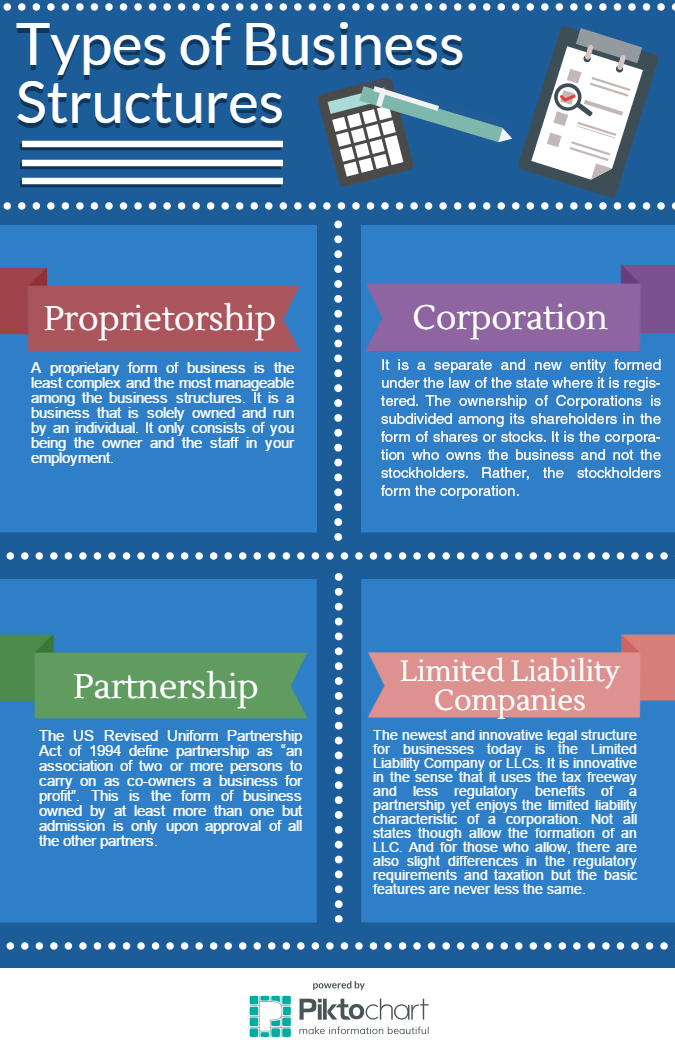Starting a business means making important decisions early on, and one of the most crucial choices is selecting the right business structure. The structure you choose can impact everything from daily operations to taxes and personal liability. For startups, the most common business structures include sole proprietorships, partnerships, limited liability companies (LLCs), and corporations. Each option offers its own advantages and considerations, so it’s essential to understand how they fit with your goals.
Let’s take a quick look at these different business structures to help you find the best fit for your startup.
Business structure defines the complexity of your business organization. It either helps or limits your ability to raise funds and capital. It may subject you to or shield you from federal duties and taxes. Most importantly, it will either protect your personal assets from creditors or legally give them the right to go after you.
Types of Business Structures
Proprietorship

A sole proprietorship is the simplest and most straightforward business structure. It’s owned and operated by a single individual, making it easy to manage and set up. As the sole owner, you have complete control over the business, while any employees you hire work directly under your management. This structure is ideal for those who want full ownership with minimal complexity.
Fast Decision-Making: In a sole proprietorship, decision-making is quick and straightforward since you, as the owner, have full control over all aspects of the business. While you can seek advice from partners, friends, clients, or consultants, the ultimate responsibility for day-to-day operations and strategic decisions rests entirely with you. This independence allows for swift action without the need for approval from others.
Minimal Regulation: Starting a sole proprietorship is relatively simple, requiring only the necessary permits and licenses to operate legally. The specific requirements may vary depending on your state and industry, but there are no complex formalities or regulatory hurdles compared to other business structures.
Personal Income Tax: Sole proprietorships do not face separate business taxes. Instead, the business’s income is considered your personal income, and you report it directly on your Individual Income Tax Return (ITR). You’ll pay taxes based on your total personal earnings, making tax filing simpler than with other business forms.
Limited Capital: The capital available to a sole proprietorship is typically limited to your personal savings or funds from loans. Without access to shareholders or investors, financing options may be restricted to personal credit or bank loans.
Unlimited Liability: One of the significant risks of a sole proprietorship is unlimited liability. In the event of business closure or bankruptcy, creditors can pursue your personal assets to satisfy any outstanding debts. These assets will be distributed in a set order: first to the government for unpaid taxes, then to creditors, and lastly to employees for unpaid wages, if applicable.
Best for Small Businesses: A sole proprietorship is well-suited for small businesses with low capital requirements, minimal employees, and where the owner has a deep understanding of the industry and plans to be hands-on in managing the business. It’s ideal for those seeking simplicity and full control.
Partnership

The US Revised Uniform Partnership Act of 1994 defines a partnership as “an association of two or more persons to carry on as co-owners a business for profit.” In this business structure, ownership is shared by two or more individuals, but new partners can only be admitted with the approval of all existing partners. This collaborative approach allows for shared responsibility and decision-making, but it also requires consensus when bringing on new members.
Partner Contributions and Profit Sharing: Each partner contributes either money, property, or services to the business, with profits and losses distributed according to the agreed-upon terms among the partners.
Collaborative Decision-Making: Key decisions, such as profit and loss distribution, dispute resolution, and dissolution, are made collectively by the partners based on a mutual agreement. All major business activities and decisions are governed by this partnership agreement, ensuring that everyone has a voice in the operation.
Joint Liability: Each partner is jointly and individually liable for the actions and decisions made by others under the partnership agreement. Although a written agreement isn’t legally required, it’s strongly advised to formalize it in writing for legal protection and transparency.
Increased Capital Through More Partners: Raising funds is generally easier than in a sole proprietorship since multiple partners can contribute. However, the capital is still limited to the contributions of the partners themselves.
Minimal Regulations: Forming a partnership is straightforward, requiring only the selection of the partnership structure when registering the business. While regulations vary by industry and location, partnerships must file an Annual Information Return to report profits, losses, and significant transactions.
No Business Income Taxes: Partnerships are not taxed as entities. Instead, profits or losses are passed through to the partners, who then report their share on their individual tax returns.
Types of Partners and Liabilities:
- General Partners: These partners have unlimited liability, similar to sole proprietors, meaning their personal assets are at risk to satisfy business debts. In a general partnership, profits and losses are typically divided equally unless otherwise specified.
- Limited Partners: These partners have liability limited to the extent of their contributions. They are protected from creditors beyond their investment in the business and have limited involvement in business decisions. The presence of at least one limited partner creates a Limited Partnership.
Dissolution Upon Partner Change: A unique feature of partnerships is that a change in the composition of partners—through death, withdrawal, or dismissal—automatically dissolves the partnership. However, this doesn’t necessarily mean the business must close. The remaining partners can form a new partnership without needing to re-register the business, simply by updating the Annual Information Return and creating a new partnership agreement.
Best for Service-Based Businesses: Partnerships are ideal for businesses primarily offering services, such as law firms or accounting practices, where collaboration among skilled professionals is key to success.
Corporation

A corporation is a legal entity that is separate from its owners, providing limited liability protection to its shareholders. Under this structure, the business is owned by shareholders but managed by a board of directors and corporate officers. Unlike partnerships or sole proprietorships, a corporation can raise capital by issuing stock, and ownership can be transferred through the sale of shares. This structure offers long-term stability, but it comes with more regulations, formalities, and potential tax implications compared to other business forms.
New Legal Entity: A corporation is a separate legal entity formed under state law. Ownership is divided among shareholders through shares or stocks, meaning the corporation—not the shareholders—owns the business. The shareholders, in turn, form the corporation.
Ownership Through Stocks: Shares represent ownership in the corporation and are typically documented through stock certificates. These shares grant shareholders a residual interest in the company’s assets and earnings.
Corporate Officers: Shareholders elect corporate officers, who form the top management and are responsible for the corporation’s operations and daily decision-making.
Decentralized Decision-Making: Major decisions, such as declaring dividends, are made collectively by shareholders, as outlined in the Articles of Incorporation. This can make the decision-making process more complex and slower than in sole proprietorships or partnerships.
Strict Regulations and Documentation: Corporations are heavily regulated and must register with the Securities and Exchange Commission (SEC). Common registration requirements include the Articles of Incorporation, a list of corporate officers, and details on stock issuance. Corporations are also required to submit periodic reports and fully document their transactions to meet federal and regulatory standards.
Easier Capital Raising: Corporations have greater access to capital through the sale of stocks, especially through Initial Public Offerings (IPOs), where the public can buy shares and become partial owners. This gives corporations nearly limitless potential to raise funds.
Double Taxation: Unlike other business structures, corporations are taxed on their earnings. After paying corporate taxes, profits distributed to shareholders as dividends are taxed again on the individual level, leading to double taxation.
Dividend Distribution: Corporations must pass a board resolution before distributing dividends to shareholders, adding a formal step before shareholders can receive a share of profits. This differs from the more flexible profit-sharing processes in sole proprietorships and partnerships.
Limited Liability: One of the key benefits of a corporation is limited liability. Shareholders are only liable for the amount they’ve invested, and their personal assets are protected from business debts.
Succession and Longevity: Corporations have the advantage of continuity, as they can exist indefinitely, with ownership transferring through the sale of shares. This makes it easy for a corporation to continue operating beyond the original owners, without requiring approval from all shareholders. Corporations can last for generations, often exceeding a hundred years with renewable charters.
Best Fit for Large Businesses: Corporations are ideal for large-scale operations with significant capital needs and a large number of employees. They are particularly well-suited for businesses that require substantial funding, wide geographic reach, and a complex organizational structure.
Limited Liability Companies (LLC)

A Limited Liability Company (LLC) combines the flexibility of a partnership with the liability protection of a corporation. In an LLC, owners—known as members—are not personally liable for the company’s debts or legal obligations. This structure offers flexibility in management, allowing members to run the business directly or appoint managers. Additionally, an LLC provides tax advantages, as profits and losses can pass through to the members without being subject to corporate taxes. It’s a popular choice for small to medium-sized businesses seeking protection without the formalities of a corporation.
Limited Liability: In an LLC, the owners, referred to as “members,” are protected from personal liability. This means they are only liable for the company’s debts and obligations up to the amount of their investment, providing a significant safeguard for personal assets.
Fewer Regulatory Requirements: LLCs require less documentation and record-keeping compared to corporations. While LLCs must file Articles of Organization, which outline the basic details of the company and its members, the overall registration process involves less paperwork. LLCs must include “LLC” or “Limited Company” in their name. For a deeper understanding, refer to this guide on “Limited vs Unlimited Company.”
Profit and Loss Sharing: Similar to partnerships, LLC members contribute capital, services, or property to the business. Profits and losses are then distributed according to an agreement between the members, offering flexibility in how the business’s financial gains or losses are shared.
Pass-Through Taxation: An LLC is not taxed as a separate entity. Instead, its profits and losses are “passed through” to the members, who report their share on their individual income tax returns. This avoids the double taxation corporations face, making LLCs an appealing option for many business owners.
Dissolution Like Partnerships: The withdrawal, death, or dismissal of a member triggers the dissolution of an LLC. The remaining members can decide to either form a new LLC or dissolve the business altogether. State regulations may vary, and in some instances, LLCs may be taxed like corporations depending on the industry or location. Always check with your State Office to confirm the appropriate legal structure options for your business.
While choosing the right legal structure is crucial for your startup, it’s not set in stone. Many statutes allow businesses to transition from one structure to another as their needs evolve.
To help with your decision, I’ve created a summarized comparison table outlining the key characteristics of various business structures, including organization, decision-making, capital, taxation, regulations, liability, and the process of dissolution.
If your initial choice doesn’t fully align with your business’s growth or needs, don’t hesitate to transition to a more suitable structure. Just ensure you follow all necessary regulatory requirements when making the switch.
Now that you’ve been introduced to the different legal structures available for your business, it’s time to choose the one that best fits your needs. Carefully weigh the pros and cons of each. It’s also wise to seek professional advice from local experts, such as business consultants, lawyers, accountants, and experienced entrepreneurs. Remember, starting and running a business will always come with challenges, but with the right structure and preparation, you’ll be set up for success. Choose wisely and embrace the journey ahead!
Sources:
US Small Business Administration
The Uniform Partnership Act (1997)
Tax Information for Businesses
Limited Partnership










